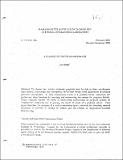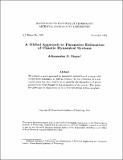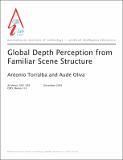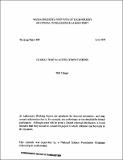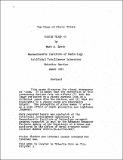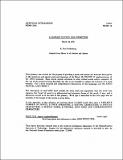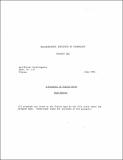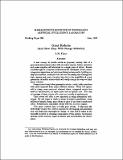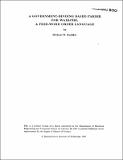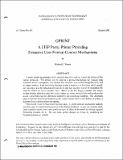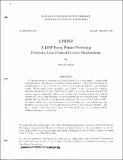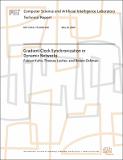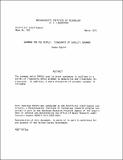Browsing Computer Science and Artificial Intelligence Lab (CSAIL) by Title
Now showing items 1424-1443 of 3804
-
A Glimpse of Truth Maintenance
(1978-11-01)To choose their actions, reasoning programs must be able to draw conclusions from limited information and subsequently revise their beliefs when discoveries invalidate previous assumptions. A truth maintenance system ... -
A Global Approach to Parameter Estimation of Chaotic Dynamical Systems
(1992-12-01)We present a novel approach to parameter estimation of systems with complicated dynamics, as well as evidence for the existence of a universal power law that enables us to quantify the dependence of global geometry ... -
Global Depth Perception from Familiar Scene Structure
(2001-12-01)In the absence of cues for absolute depth measurements as binocular disparity, motion, or defocus, the absolute distance between the observer and a scene cannot be measured. The interpretation of shading, edges and junctions ... -
Global Time in Actor Computations
(MIT Artificial Intelligence Laboratory, 1979-06) -
The Gloss of Glossy Things
(MIT Artificial Intelligence Laboratory, 1973-03)This paper discusses the visual phenomenon of gloss. It is shown that the perception of this phenomenon derives from two effects (1) that the image reflected by a glossy surface lies in a different plane from the surface, ... -
A Glossary of LOGO Primitives
(1974-12-01)This is a brief description of the primitives in PDP 11 LOGO. It is intended to provide a quick reference for users who are already familiar with LOGO basics. For a more detailed and comprehensive description of LOGO, ... -
A Glossary of PDP11 LOGO Primitives
(1975-03-01)This glossary was written for the purpose of providing a quick and concise yet accurate description of the primitives and special words and characters of the March 18, 1975 PDP 11 implementation of the LOGO languge. ... -
-
Gnat Robots (And How They Will Change Robotics)
(MIT Artificial Intelligence Laboratory, 1987-06)A new concept in mobile robots is proposed, namely that of a gnat-sized autonomous robot with on-board sensors, brains, actuators and power supplies, all fabricated on a single piece of silicon. Recent breakthroughs in ... -
A Government-Binding Based Parser for Warlpiri, a Free-Word Order Language
(1987-01-01)Free-word order languages have long posed significant problems for standard parsing algorithms. This thesis presents an implemented parser, based on Government-Binding (GB) theory, for a particular free-word order ... -
GPRINT - A LISP Pretty Printer Providing Extensive User Format-Control Mechanism
(1981-10-01)A pretty printer is presented which makes it easy for a user to control the format of the output produced. The printer can be used as a general mechanism for printing data structures as well as programs. It is divided ... -
GPRINT: A LISP Pretty Printer Providing Extensive User Format Control Mechanism
(1982-09-01)A Lisp pretty printer is presented which makes it easy for a user to control the format of the output produced. The printer can be used as a general mechanism for printing data structures as well as programs. It is ... -
GPSG-Recognition is NP-Hard
(1985-03-01)Proponents of generalized phrase structure grammar (GPSG) cite its weak context-free generative power as proof of the computational tractability of GPSG-Recognition. Since context-free languages (CFLs) can be parsed ... -
Gradient Clock Synchronization in Dynamic Networks
(2009-05-29)Over the last years, large-scale decentralized computer networks such as peer-to-peer and mobile ad hoc networks have become increasingly prevalent. The topologies of many of these networks are often highly dynamic. This ... -
Grammar as a Programming Language
(1976-10-01)This paper discusses some student projects involving generative grammars. While grammars are usually associated with linguisitics, their usefuleness goes far beyond just "language" to make different domains. Their ... -
Grammar for the People: Flowcharts of SHRDLU's Grammar
(1973-03-01)The grammar which SHRDLU uses to parse sentences is outlined in a series of flowcharts which attempt to modularize and illuminate its structure. In addition, a short discussion of systemic grammar is included. -
Grammar Rewriting
(1991-12-01)We present a term rewriting procedure based on congruence closure that can be used with arbitrary equational theories. This procedure is motivated by the pragmatic need to prove equations in equational theories where ... -
The Graph Display as an Aid in the Monitoring of a Time-shared Computer System
(1968-10)The problem of dynamic observation of the state of a time-shared computer system is investigated. The Graphical Display Monitoring System was developed as a medium for this experimental work. It is an integrated system ... -
A Graph Model for Parallel Computations
(1969-09)This report presents a computational model called program graphs which makes possible a precise description of parallel computations of arbitrary complexity on non-structured data. In the model, the computation steps ...

